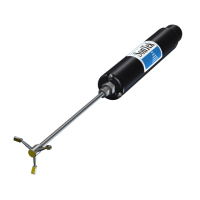SonTek/YSI
ADVField Software Manual (September 1, 2001) 40
9.5. Extracting Time-Series Data (GADVTS)
The
GADVTS
program extracts the time-series data from an autonomous ADVField data file. This
includes all data recorded with each sample: velocity, signal amplitude, correlation, compass
data (if enabled), and sensor data (if enabled). The command syntax is:
GADVTS [ADV file] [burst type] [output file] [first burst] [last burst]
File names must be given without an extension.
GADVTS
assumes the autonomous ADV data file
has extension
.ADR
, and it assigns the extension
.TS
to the output file.
If
[burst type]
is not specified, it will extract data for burst type #1 (acceptable burst types are
1 through 3). See the ADVField Operation Manual for a description of multiple-burst sampling.
Data for only one burst type can be converted at one time.
If
[output file]
is not specified,
GADVTS
uses the same root name as the data file. If
[first
burst]
and
[last burst]
are not specified, it will extract data for all bursts. For example,
GADVTS WAVES001
extracts all time-series data for burst type 1 from
WAVES001.ADR
and places the output in an AS-
CII file named
WAVES001.TS
. As another example,
GADVTS WAVES001 2 WAVES 10 50
extracts time-series data for burst type 2, bursts 10 through 50, from the file
WAVES001.ADR
to
file
WAVES.TS
.
The output file format has one line for each sample. A series of lines forms a table that can be
easily read by a variety of analysis programs. The number of values per line (and hence the num-
ber of columns per table) will vary depending on which recording options were enabled. The first
two columns are always burst number and sample number within that burst.
Appendix 2 of the ADVField Operation Manual has a table that shows what type of data are ex-
tracted and in what order based on the selected recording options. A description of each type of
data are also included in the appendix.

